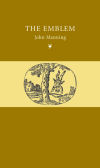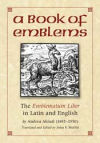


Official State Emblems
State emblems cannot be easily defined like a flower or a mineral. Emblems are not things. They are designs that represent things. Most often the emblem label goes hand in hand with a specific designation. The Commonwealth of Massachusetts often defines their symbols as "such-and-such and such-and-such emblem" (e.g. by law, the mayflower "shall be the flower or floral emblem of the commonwealth.")
Only two states have designated an emblem that is not part of another designation; New Hampshire and Utah.
Calling New Hampshire's Old Man of the Mountain its official emblem is misleading, though we sometimes do it. The "emblem" is not really the now-collapsed rock outcropping that resembled the profile of an old man. By law, the emblem is an elliptical design that features the state name, the state motto, and an artist's representation of the Old Man of the Mountain.
Utah's law simply states "Utah's state emblem is the beehive." The design of the beehive is left undefined.
Emblems represent other things. The following equates an emblem to the thing it represents. The use of the term "floral emblem" is most popular.
- Floral emblem ~ Flower
- Mineralogic emblem ~ Mineral
- Lithologic emblem ~ Rock
- Arboreal emblem ~ Tree
| Official emblems listed by state. (List by state or year) | |||
State |
Name | Designated as | Year |
|---|---|---|---|
| Alabama | [ None ] | ||
| Alaska | Wild native forget-me-not | Floral emblem | 1917 |
| Arizona | [ None ] | ||
| Arkansas | Apple blossom | Floral emblem | 1901 |
| California | Gold | Mineralogic emblem | 1965 |
| California | Serpentine | Lithologic emblem | 1965 |
| Colorado | [ None ] | ||
| Connecticut | [ None ] | ||
| Delaware | Peach blossom | Floral emblem | 1895 |
| Florida | [ None ] | ||
| Georgia | Cherokee rose | Floral emblem | 1916 |
| Hawaii | [ None ] | ||
| Idaho | [ None ] | ||
| Illinois | [ None ] | ||
| Indiana | [ None ] | ||
| Iowa | [ None ] | ||
| Kansas | Wild native sunflower | Floral emblem | 1903 |
| Kentucky | [ None ] | ||
| Louisiana | [ None ] | ||
| Maine | Pine cone and tassel | Floral emblem | 1895 |
| Maryland | [ None ] | ||
| Massachusetts | Mayflower | Floral emblem | 1918 |
| Massachusetts | Cod | Fish emblem | 1974 |
| Michigan | [ None ] | ||
| Minnesota | [ None ] | ||
| Mississippi | [ None ] | ||
| Missouri | Hawthorn blossom | Floral emblem | 1923 |
| Missouri | Flowering dogwood | Arboreal emblem | 1955 |
| Missouri | Mozarkite | Lithologic emblem | 1967 |
| Montana | Bitterroot | Floral emblem | 1895 |
| Nebraska | [ None ] | ||
| Nevada | [ None ] | ||
| New Hampshire | Old Man of the Mountain | Emblem | 1945 |
| New Jersey | [ None ] | ||
| New Mexico | [ None ] | ||
| New York | [ None ] | ||
| North Carolina | Eastern box turtle | Reptile and emblem | 1979 |
| North Dakota | [ None ] | ||
| Ohio | [ None ] | ||
| Oklahoma | Mistletoe | Floral emblem | 1893 |
| Oregon | [ None ] | ||
| Pennsylvania | [ None ] | ||
| Rhode Island | [ None ] | ||
| South Carolina | [ None ] | ||
| South Dakota | American pasque flower | Floral emblem | 1903 |
| Tennessee | [ None ] | ||
| Texas | [ None ] | ||
| Utah | Beehive | Emblem | 1959 |
| Vermont | [ None ] | ||
| Virginia | American dogwood | Floral emblem | 1918 |
| Washington | [ None ] | ||
| West Virginia | [ None ] | ||
| Wisconsin | [ None ] | ||
| Wyoming | [ None ] | ||

The Emblem, by John Manning. 304 pages. Publisher: Reaktion Books (June 2, 2004) The emblem, an image accompanied by a motto and a verse or short prose passage, is both art and literature: in the emblem tradition, the image presents a story – often with pictorial symbols – and the verse below it drives home the picture-story's moral instruction. It is one of the most fascinating, and enduring, art forms in Western culture. John Manning's book charts the rise and evolution of the emblem from its earliest manifestations to its emergence as a genre in its own right in the sixteenth century, and then through its various reinventions to the present day. |
|||

A Book of Emblems: The Emblematum Liber in Latin and English, by Andrea Alciati. 268 pages. Publisher: McFarland & Company (June 2004) Andrea Alciati’s Emblematum Liber was an essential work for every writer, artist and scholar in post-medieval Europe. First published in 1531, this illustrated book was a collection of emblems, each consisting of a motto or proverb, a typically enigmatic illustration, and a short explanation. Most of the emblems had symbolic and moral applications. Scholars depended on Alciati’s book to interpret contemporary art and literature, while writers and artists turned to it to invest their work with an understood didactic sense. This new edition of the Emblematum Liber includes the original Latin texts, highly readable English translations, and the illustrations belonging to each of the 212 emblems. The editor’s introduction explains both the importance and the cultural contexts of Alciati’s book, as well as its innumerable artistic applications. For instance, close study of the emblems reveals--to cite only two examples--why statues of lions are traditionally placed before government buildings, and what underlying political message was conveyed by innumerable equestrian portraits during the Baroque era. |
|||
~~ OUR PARTNERS ~~
[ HOME
| LINK TO NETSTATE
| GUESTBOOK
]
[ SPONSORSHIPS/ADVERTISING
| PRIVACY STATEMENT
| CONTACT US
]
Site designed exclusively for NETSTATE.COM by NSTATE, LLC

NETSTATE.COM is a Trademark of NSTATE, LLC.
Copyright © by NSTATE, LLC. All rights reserved.
No copyright is claimed on non-original or licensed material.
Support NETSTATE
